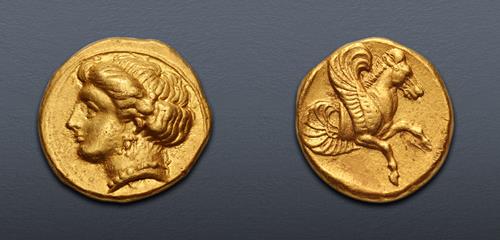|
MYSIA, Lampsakos. Circa 394-350 BC. AV Stater (16.5mm, 8.39 g, 11h). Head of female left, wearing triple-pendant earring and necklace / Forepart of Pegasos flying right within shallow incuse square. Baldwin, Lampsakos 27; SNG BN 1156 = Traité II 2565 (same obv. die); G.F. Hill, “Greek coins acquired by the British Museum in 1919,” NC 1920, p. 111 and pl. XIV, 6 = Weber 5102 (same obv. die). Underlying luster. Good VF. Struck from artistic dies. Extremely rare, one of only three known, the other two in museum collections (the BN and BM).
From the Father & Son Collection. Ex Jonathan P. Rosen Collection (Triton XXIII, 14 January 2020), lot 318; Roma XIII (23 March 2017), lot 291; Triton X (9 January 2007), lot 273.
Both the BN and BM specimens are struck from the same die pair. The present coin adds a new reverse die to the corpus.
Lampsakos depended upon the traffic between the Aegean and the Black Sea, and possessed an excellent harbor in a strategic position guarding the eastern entrance to the Hellespont opposite Gallipolis. The city was known to have existed under the name of Pityusa before it received colonists from the Ionian cities of Phokaia and Miletos (Strabo xiii, p. 589). In the sixth and fifth centuries Lampsakos passed successively under Lydian, Persian, Athenian, and Spartan control. Its tribute of twelve talents, as a member of the Delian League, and production of electrum staters in the fifth century, attest to its commercial wealth. Following the example and standard of the Persic daric, Lampsakos was the first Greek city to make regular issues of gold coinage, which enjoyed an international circulation from Sicily to the Black Sea. As at Kyzikos, the quality of engraving was very high, and types changed frequently: approximately forty types were produced in a period of about sixty years. Many of the types contemporary with the present coin feature chthonic deities, those whose powers came from the earth, such as Demeter and Dionysos. The female on the obverse of this coin, though, does not have any characteristics that identify her as a particular deity, and she may simply be the representation of a nymph in the local folklore.
The final winners of all CNG Feature Auction 121 lots will be determined during the live online sale that will be held on 6-8 October 2022. This lot is in Session One, which will begin 6 October 2022 at 9 AM ET.
Winning bids are subject to a 22.5% buyer's fee for bids placed on this website and 25% for all others.
We recognize that our users may have various Internet Browsers and Operating Systems. We like our visitors to have the best possible experience when using our bidding platform. However, we do recognize that it is impossible to develop applications that work identically, efficiently and effectively on all web browsers. The CNG bidding platform supports the latest stable major version and stable previous version of Chrome and Firefox.
|
